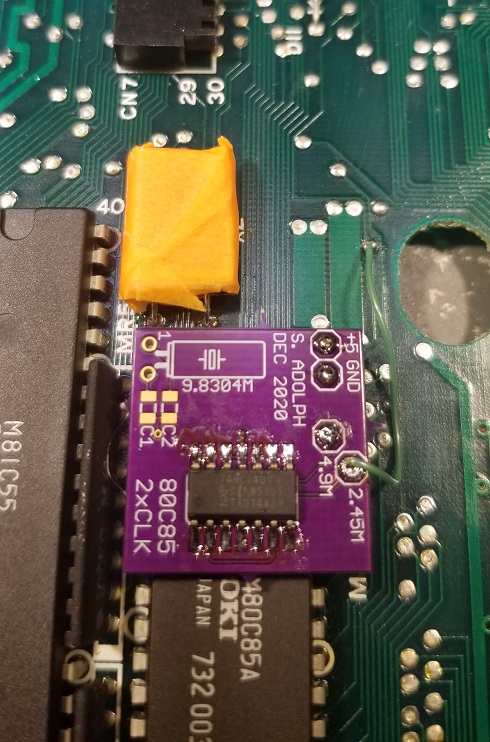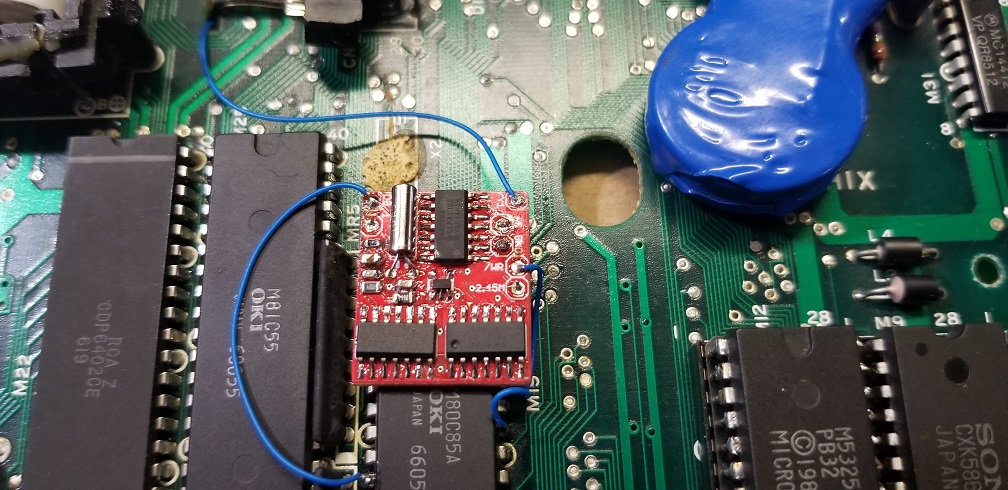5MHZ upgrade for Model T
Updated November 2023 work in progress
Goal of this page is to share the latest in a long sequence of "clock doubler" boards for the 80C85 used in the Model T computers.
Goals
* support for all Model T computers - M100, T102, T200, PC-8201, PC-8300, M10, KC-85 * buildable with moderate effort and skill * minimal and reversible modification to the computer
Features
* software switchable speed up for compatibility * settable power-up default speed, 1x or 2x * hardware driven 1x slowdown function (needed for T200) * accelerated RAM timing signal (needed for M100, T102, NEC, KC-85, M10) * single sided component placement * 3 different crystal placement options for mechanical fit flexibility * surface mount logic, leaded through-hole passives * low power consumption
PCB and Schematic
Technical discussion
I've invested some time in trying to make the simplest possible 5M upgrade for M100. M100 has a couple of issues to overcome
1) the main ROM is too slow. This is easily overcome by swapping in an EPROM. 2) on early M100s the system RAM is also (barely) too slow. Early RAM modules were 250nsec SRAM.
M100
T102
T200
I now have a very nice solution that allows one to keep using the original SRAM. The solution involves modifying the A* signal that is used to enable the SRAM. By speeding it up a touch, you can use the original SRAMs (and really any M100 SRAM modules).
I'll soon be posting a much revised solution for M100. The great news is also that I've really tuned the power consumption. My test M100 had a stock current of about 50mA. Running 5MHz the current jumped to 70mA. This is a nice result, better than I have had in the past with other designs. And you are spending less power per CPU cycle.. so it is a GREEN solution! hah.
Switchable solutions
In the M100/T102, port /Y1 is free to use. So, for switchable implementations
Power up default is 2.5 MHz OUT144,0 sets to 2.5MHz OUT144,1 sets to 5MHz
Current Upgrades Status
| Computer model | Fixed 5MHz | Switchable 5MHz |
| T102 | PCBs, V1.2 instructions available | PCB available |
| M100 | PCBs, V1.1 instructions available | PCBs available |
| M100 (UK) | like M100, but no need for new EPROM | like M100, but no need for new EPROM |
| M100+NSC800 | contact me | - |
| T200 | not yet investigated | not yet investigated |
| PC-8201 | not yet investigated | not yet investigated |
| KC-85 | like M100? | like M100? |
As I test and more-or-less land on a reasonable upgrade process, I will post instruction files here If you have any questions, please get in touch with me at Twospruces at --the google mail service.
Also, since OSHPARK is so clumsy in dealing with PCB revisions (basically you can't remove a bad file design once shared), I've decided to just post PCB gerber files and schematics here. That way I can control issues that I find and always have the corrected files available.
What are the tradeoffs?
A fixed solution makes your laptop always run at 5MHz. A switchable solution gives you the option of standard operation or "TURBO mode". The switchable solution is a nice way to go. Switch up when needed, switch down when necessary.
Some of the considerations are captured below.
Laptop functionality
| Item | Fixed 5MHz | Switchable 5MHz |
| Processor speed | 5MHz | 2.5 or 5 MHz |
| LCD | 5MHz | 2.5 or 5 MHz |
| I/O | 5MHz | 2.5 or 5 MHz |
| BCR | 5MHz | 2.5 or 5 MHz |
| Cassette | assumed non functional | functional in 2.5 MHz mode |
| Modem | standard | standard |
| Printer | standard | standard |
| Power consumption | ~40% higher | ~40% higher in 5MHz mode |
Complexity of modifications
| Item | Fixed 5MHz | Switchable 5MHz |
| Clock PCB assembly ease | easiest | small SMT soldering |
| Crystal location | swap onboard | mounted on adapter board |
| Clock PCB installation ease | easiest | additional wiring |
| M100 ROM upgrade | challenging to build | challenging to build |
| M100 main PCB cut tracks? | one clock trace | one clock trace |
| T102 main PCB cut tracks? | one clock trace and RAM mod | one clock trace and RAM mod |
| Reversible? | yes, remove hack and repair cut tracks | yes, remove hack and repair cut tracks |
What about compatibility with REX#/REXCPM?
REX# and REXCPM from November 2021 are built and tested compatible with 5MHz. In fact my test station runs at 5MHz. If you have an earlier REX#/REXCPM, contact me to discuss what to do.
Instructions
Take a look at the instruction files below. Please don't try this if you are not confident of success! I welcome feedback and comments. Especially if you find errors or improvements.
Fixed 5MHz Upgrades
| Computer model | Version | Upgrade file | Power consumption at 5MHz |
| T102 | Fixed 2x upgrade V1.2 | T102 5MHz mod V1.2 Apr2 2022.pdf | 80-100mA |
| M100 | Fixed 2x upgrade V1.1 | M100 5MHz mod V1.1 Apr 2022.pdf | 80-100mA |
| T102 | Fixed 2x upgrade V2.0 | T102 5MHz mod V2.0 .pdf | 65-75mA |
| M100 | Fixed 2x upgrade V2.0 | M100 5MHz mod V2.0 .pdf | 65-75mA |
Comments on these upgrades
Power consumption:
While effective, and simple, these two initial upgrade designs suffer from higher current than is desirable. Typical M100/T102 have power consumption in MENU of about 50 mA. I have observed that using these conversions, power can be between 80 and 100 mA. This seems to be due in part to how this conversion modifies the A* circuit.
Both of these initial conversions use a simple change to the A* circuit. Here the A* signal is tied to +5V, meaning the RAM is enabled quite early in the CPU cycle. While there is no conflict with this wiring, I now appreciate that there is an advantage to reducing the time over which the SRAM chips are enabled.
A* is used, in the standard design, to enable the SRAM only when there is an active READ or WRITE, driven by the /RD and /WR signals. This has the effect of turning the SRAM on for the minimum time duration.
SRAM has a fairly significant power draw when selected. So when the A* signal timing is modified (which is needed to support 5MHz operation), the longer the SRAM stays "on" the more power it consumes.
The good news is that I have a design that drops the RAM power significantly. I'll be posting that design shortly.
NSC800 / CP/M @ 5MHz
For M100 with NSC800, contact me for a solution. This would of course be a dedicated CP/M machine with REXCPM installed.
Switchable 5MHz Upgrades
| Computer model | Version | Upgrade file |
| T102 | Switchable 2x upgrade V1 | design is done. working on docs |
| M100 | Switchable 2x upgrade V1 | design is done. working on docs |
PCBs
Posted here so I can maintain and update the designs, are Gerber files and layout images.
| PCB | Version | Comments | Gerbers | Image |
| Fixed 5MHz clock board (/2 board) | This board has no small surface mount parts and uses main board crystal. Easiest! Does not include A* signal generation, so induces higher than ideal power consumption. | V2 | Divide by 2 PCB Gerbers | 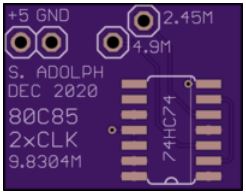
|
| Fixed 5MHz clock board (/2 board) + A* | This board has no small SMT and uses main board crystal. Includes A* generation to reduce power consumption to minimum. | V1 | Divide by 2 + A* PCB Gerbers | 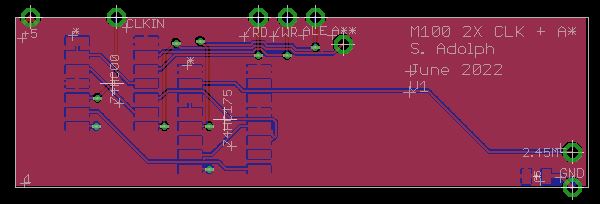
|
| Switchable 5MHz clock board + A* | Switchable design, with onboard crystal, timing generation and A* function. Harder to build, has small surface mount parts. | V4 | Switchable 2x/1x + A* PCB Gerbers | 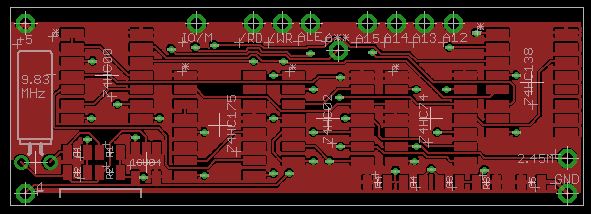
|
Photos
T102 with a fixed 5MHz board. This board is easy to make, and the 10M crystal is on the main board. No small SMT soldering! Note: what is shown is an early board. Latest board is more compact and eliminates the unused parts.
T102 with a switchable 5MHz board. This board has to use a crystal on the clock board, and has small SMT soldering. Harder to build, but has switchable clock.
This board is good, but there is a better solution.
FAQ
As this is tried I'm sure questions and comments will arise. We can capture useful information here. Thanks.
